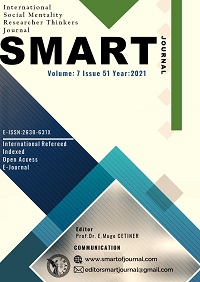Author :
Abstract
ALAN: TÜRK HALKBİLİMİ Bugün Anadolu’da, hem Sünnilerce hem de Alevî-Bektaşî inancına mensup kimselerce yapılan aşure, bağlandığı tarihî arka planı, yapılış amacı, aşure günün öncesi, yapılış aşaması ve sonrasında uygulanan bir takım pratikler ve inanmalarla farklılıklar arz etmektedir. Bu çalışmanın amacı ise, bolluğa berekete duyulan şükran niyetine ailece yenen, komşulara iyi dileklerle, dualarla dağıtılan aşurenin Türk kültürünün özünde var olan “Yaratan ve insan sevgisi”ni ve bu bağlamda “özde birliği” ortaya koyduğunu vurgulamaktır. Çalışmanın deseni temel nitel araştırma olup yöntem olarak sahada derleme çalışması/görüşme ve katılımcı gözlem seçilmiştir. Örneklem için onamları alınmış gönüllü on kaynak şahısla yüz yüze görüşme yapılmış, kaynak şahıslar numara ile şifrelendirilerek çalışma sonunda sunulmuştur. Ayrıca doküman analiziyle de nitel desen desteklenmiştir. Derleme verileri ise, yorumsamacı nitel desene uygun bir şekilde betimsel analiz ile ele alınmıştır. Çalışma sonunda, Türk halkının “Kerbelâ Trajedisi ve Nuh’un Gemisi” gibi konularda ortak kültürel bellekte birleştiği, hafızadaki bilgiyi Yaratan ve insan sevgisiyle sözlü gelenek- kültürel miras yoluyla aktardığı gözlenmektedir.
Keywords
Abstract
Today in Anatolia, ashura is made by both Sunnis and people of the Alevi-Bektashi faith differs in terms of its historical background, the purpose of making it, and some practices and beliefs applied before, during and after the day of Ashura. The aim of this study is to emphasize that ashura, which is eaten as a family with the intention of gratitude for abundance and blessings, and distributed to neighbors with good wishes and prayers, reveals the "love of God and human being" inherent in Turkish culture and, in this context, "unity in essence". The pattern of the study is basic qualitative research. In the study, compilation study/interview and participant observation were chosen as the method. Face-to-face interviews were conducted with ten volunteer resource persons whose consent was taken for the sample. The source persons were presented at the end of the study by ciphering them only with numbers. In addition, the qualitative design was supported by document analysis. The compilation data, on the other hand, were handled with descriptive analysis in accordance with the hermeneutic qualitative design. As a result of the study, it was seen that the Turkish people were united in a common cultural memory on issues such as the "Karbala tragedy and Noah's Ark". In addition, it is observed that the knowledge in memory is transmitted through oral tradition and cultural heritage with the love of God and human beings.
Keywords
- Akbulut, D. (2010). “Bektaşi Kazanlarından Saray Aşurelerine Bir Paylaşım Geleneği Olarak Aşure”. Türk
- Akbulut, D. (2010). “Bektaşi Kazanlarından Saray Aşurelerine Bir Paylaşım Geleneği Olarak Aşure”. Türk Kültürü ve Hacı Bektaş Veli Araştırma Dergisi, S. 55: 269-279.
- Büyüköztürk, Ş. & Kılıç, Ç. E. & Akgün, Ö. E. & Karadeniz, Ş. & Demirel, F. (2012). Bilimsel Araştırma Yöntemleri (11. bs.). Pegem Akademi, Ankara.
- Devellioğlu, F. (1990). Osmanlıca-Türkçe Ansiklopedik Lügat, Aydın Kitabevi, Ankara.
- Gazali (2014). Kalplerin Keşfi - Tam metin İmam-ı Gazali (24. Baskı), Araf Yayınları, İstanbul.
- Merriam, S. B. (2009). Nitel Araştırma Desen ve Uygulama İçin Bir Rehber (Gözden geçirilmiş yeni basım,üçüncü basımdan çeviri, Çeviri Ed. S. Turan), [Qualitative Research A Guide to Desing and Implementation, Sharan B Merriam (Third Edition)] Nobel Yayınları, Ankara.
- Önal, M. N. (2013). “Muğla’da Alevi- Tahtacı Kültürü”. Turkish Studies - International Periodical For The Languages, Literature and History of Turkish or Turkic, 8 (9): 343-366.
- Önal, M. N. (2021) “Türk Halk Müslümanlığında Miraç Algısı”. ERDEM, Haziran 2021; Sayı 80: 89-110.
- Özlü, Z. (2014). “Osmanlı Sarayında Aşure Geleneği Uygulamasına Dair”. Millî Folklor, 26 (101): 209-220.Polat, K. (2019). “Aşure Geleneğinin Tarihsel Arka Planı ve Osmanlı Kültür Dünyasına Yansımaları”. Akademik Dil ve Edebiyat Dergisi, 3 (4): 457-474.
